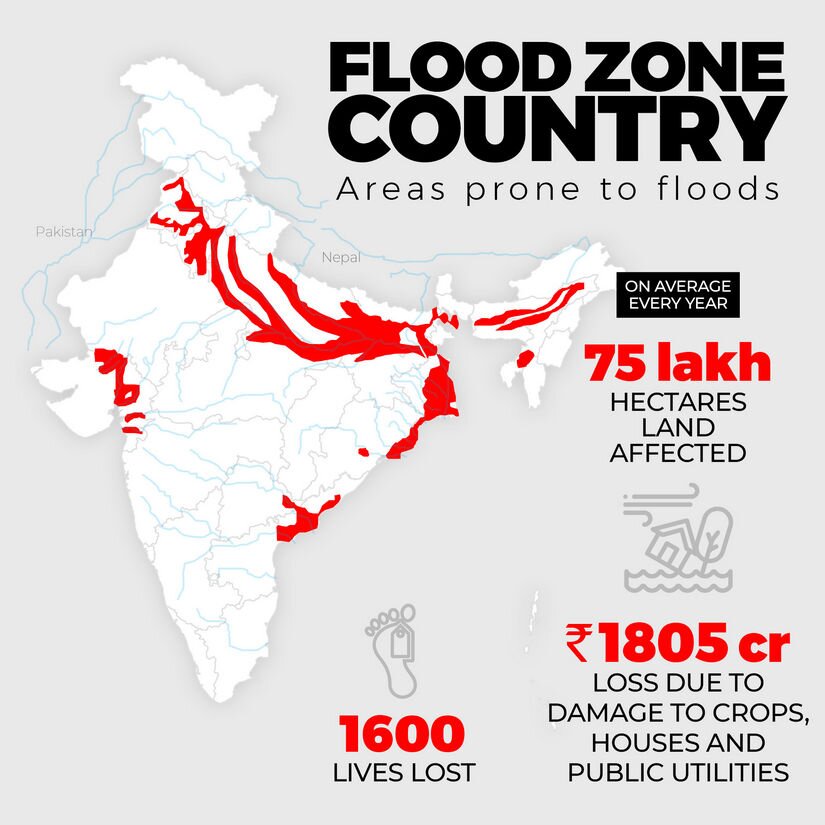Flood Management In India
This article is based on “Evolve an integrated response to floods” which was published in The Hindustan Times on 06/07/2020. It talks about the need for an Holistic Flood Management framework In India.
Recently, floods in Assam and other north-eastern states have caused devastation of life and property, which is an annual problem in the region. However, floods are not restricted to North-eastern India, rather it affects many other areas in the country.
Apart from natural factors like incessant and heavy rainfall during the monsoon, there are man-made factors that contribute to floods in India.
India is highly vulnerable, as most of its geographical area is prone to annual flooding. The high losses and damages due to floods show the poor adaptation and mitigation status of India and inadequacy in disaster management and preparedness.
Thus, there is a need for an Integrated flood management system.
Factors contributing to the increase in Floods
Natural Causes
- Climate Change: According to the International Panel for Climate Change, the rainfall intensity, duration and frequency are going to increase in the future.
- Also, incidence of cyclonic circulations and cloud bursts that cause flash floods are increasing due to Climate change.
- Skewed Rainfall Pattern: 80% of the precipitation takes place in the monsoon months from June to September. During this time, the rivers bring heavy sediment load from the catchments.
- These, coupled with inadequate carrying capacity of the rivers and drainage congestion and erosion of river-banks are responsible for causing floods.
- Trans-National Rivers: The fact that some of the rivers (like Brahmaputra, many tributaries of Ganga) causing damage in India originate in neighboring countries, adds another complex dimension to the problem.
- Also, sudden change in topography from high mountains to plain areas, is also a reason for floods in northern India.
- Earthquakes: An Earthquake Disaster Risk Index (EDRI), prepared by the National Disaster Management Authority (NDMA), showed that about 56% area of India is vulnerable to moderate to major earthquakes.
- As many of the river basins in India lie in earthquake-prone areas, the course of the river is not stable and amounts to flooding.
Human Causes
- Unplanned Development: Unplanned development, encroachments in riparian zones, failure of flood control structures, unplanned reservoir operations, poor drainage infrastructure, deforestation, land use change and sedimentation in river beds are exacerbating floods.
- When rainfall is heavy, the river breaches the embankments and destroys habitations along the banks and on the sandbars.
- Urban Flooding: Flooding in the cities and the towns is a recent phenomenon caused by increasing incidence of heavy rainfall in a short period of time.
- The reason for this is indiscriminate encroachment of waterways and wetlands, inadequate capacity of drains and lack of maintenance of the drainage infrastructure.
- Apart from it, poor waste management is exacerbating the problem by blocking drains, canals and lakes, while ill-planned road projects are cutting off flood flows
- Neglect of Pre-Disaster Planning: History of flood management shows that focus of disaster management has largely been on post-flood recovery and relief.
- Many reservoirs and Hydro-electric plants do not have enough gauging stations for measurement of flood level, which is the principal component for flood prediction and forecast.
Way Forward
- Disaster Preparedness Plan: A comprehensive flood management plan is needed to include Disaster preparedness.This may require strengthening of the following:
- Flood Hotspot Mapping at local and regional scale.
- Management and regulation of riparian zones to prevent spilling and erosion.
- River flood modelling to prepare for incidences like reservoir breach and emergency water release from dams.
- Advanced techniques such as mapping based on satellite imagery and Geographic Information Systems will help in development of flood early warning systems.
- Integrated Approach: Steps need to be taken for watershed management through an integrated approach. Often these approaches involve both hard engineering solutions and ecologically sustainable soft solutions.
- Hard Solutions: It involves civil engineering construction such as dams, culverts and dykes, widening and deepening of river channels and diversion channels to store and divert water to increase the lag time of water reaching downstream.
- Ecological Soft Solutions: The solutions such as restoration and management of riparian zones, afforestation along the river channels which led to retention of rainwater and reduces the river discharge.
- An integrated approach to managing floods requires a sound understanding of the patterns that rivers such as the Ganga and its tributaries display during the monsoon.
- Prioritising Buffers, Flexibility and Adaptability: This includes reviewing safety criteria of dams and canals, re-building these with higher safety factors, creating new intermediate storages, and introducing dynamic reservoir management.
- Reducing Disaster Risk Reduction: There is a need for efficient implementation of Sendai Framework for Disaster Risk Reduction, this will reduce the vulnerability of any disaster.
- Focusing on Urban Flood Management: Keeping in view the fact that the problem of Urban Flooding is becoming more severe and losses are mounting every year.
- The subject of urban flooding needs exclusive attention and the proper implementation of NDMA guidelines on Urban Flooding 2016, is the need of the hour.
Conclusion
As floods cause major damage to life and property every year, it is time the central and the state governments prepare a long-term plan that goes beyond piecemeal measures like building embankments and dredging to control floods. Also, there is a need for an integrated basin management plan that brings all the river-basin sharing countries as well Indian states on board.
|
Drishti Mains Question “The process of flood management in India is very complex due to the influence of several socio-hydroclimatological factors”. In light of this statement analyse the need for an integrated flood management framework in India. |
This editorial is based on “End of a dream” which was published in The Indian Express on July 7th, 2020. Now watch this on our Youtube channel.

